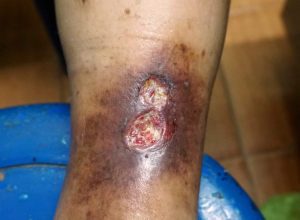
Tropical Ulcer
A tropical ulcer (also known as an Aden ulcer, jungle rot, Malabar ulcer and Tropical phagedena) is an infectious skin legion commonly seen in tropical climates. It typically occurs in cutaneous leishmaniasis, which is a skin infection caused by the bite of a sand fly. Tropical ulcers generally appear on the lower limbs, especially on the feet and ankles, but they can appear on the arms, as well.
Symptoms
Most tropical ulcers occur below the knee, usually on the feet and ankles. They begin as very painful circular skin lesions that rapidly increase in size over the course of a few days. Most have purple edges that many describe as looking “gnawed.”
As the lesions enlarge, they turn into vesicles and then into full on ulcers that can affect the underlying muscle as well as the periosteum (the fibrous membrane that covers the surface of bones). Within a couple of weeks, untreated tropical ulcers can reach several centimeters deep and may become foul smelling and necrotic (blackened due to tissue death). Pain usually dissipates at this stage.
Causes
New research indicates that tropical ulcers are actually a skin infection caused by several different bacteria. Fusobacterium species are almost always present in the initial stages of tropical ulcers, but Bacillus fusiformis, Treponema vincenti, Escherichia coli and Enterococcus may also be present.
Generally there is some initial trauma to the skin that causes tropical ulcers to form. This could be anything from a cut or scratch to an insect bite. Exposing the wound to mud or contaminated water leaves it susceptible to a tropical ulcer developing.
Poor hygiene, poor nutrition and diseases such as malaria increase a person’s chance of developing tropical ulcers. Age and sex also play a part: Children and teenagers are at a higher risk, as are women.
Treatment
Most tropical ulcers are treated with antibiotics such as penicillin, metronidazole and tetracycline. Sometimes surgical debridement and taking a skin graft are necessary, especially if the ulcer has affected deep skin tissue.
In rare cases, tropical ulcers disappear on their own. This usually takes several months, sometimes even years, and they almost always leave a significant fibrotic scar. Treatment is always recommended, however, because of the risk of gangrene and limb amputation.
Notice concerning medical entries:
Articles having medical content shall serve exclusively for the purpose of general information. Such articles are not suitable for any (self-) diagnosis and treatment of individual illnesses and medical indications. In particular, they cannot substitute for the examination, advice, or treatment by a licensed physician or pharmacist. No replies to any individual questions shall be effected through the articles.






